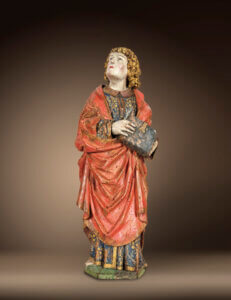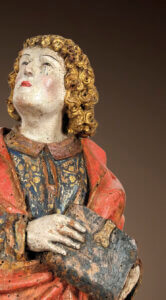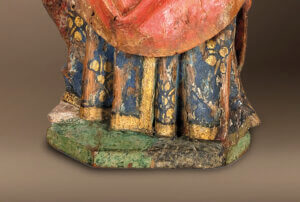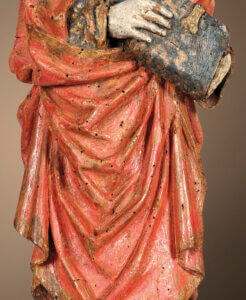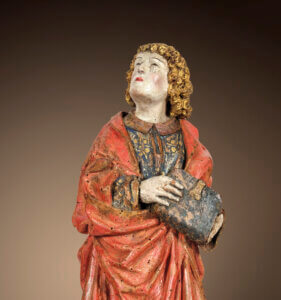St. John is an important figure in church history: as the son of Zebedee and Salome, he was called to be the fourth disciple of Jesus and was the only apostle present under the cross during the crucifixion, where Jesus called him his “favorite disciple” (Gospel of John 19, 26). There, Jesus also entrusted his mother Mary to him. He was also the first disciple to see the empty tomb and later recognized the risen Christ. He is one of the “pillars” of the early church (Galatians 2, 9) and is often equated with John the Evangelist.
This sculpture of St. John is an exceptionally fine carving from the late Gothic period. John is depicted standing; he is looking upwards, his angular face framed by thick golden curls. Narrow eyebrows lie above almond-shaped eyes; a short but prominent nose sits above a small mouth. He is holding a book in his hands, presumably the Holy Scriptures. His upper body is turned slightly to the right and he seems to be in communion with the Lord. The tears flowing down from the lower eyelids in long streams are particularly impressive. The dark blue tears contrast with the light pink cheeks, the white, crackled incarnation and the red mouth, framed by oil-gilt hair. The pathos of these details underpins John’s empathetic role in the crucifixion and calls on the viewer to do the same.
These colors are also reflected in the polychromy of the garment: his clothes with turned-up collars are dark blue with golden ornaments, like his hair. A red coat is draped over it, falling down in highly complex fold configurations. The V-shaped bowl-shaped folds at the front visually emphasize the height, further emphasized by the upward-facing view. What is unusual is the pucker that is tucked under his right elbow. This almost mannerist component lends the figure of John a decidedly vitalizing dynamism and immediacy. Parallels to the carved works of Niklaus Weckmann (active around 1481-1526 in Ulm) are recognizable: he was involved in commissioned works with the famous Jörg Syrlin and carried out carvings in Ulm in the late 15. and early A very successful sculptor’s workshop in the 16th century. Among other things, the figure of a mourning John from around 1510/20 by Weckmann (Bavarian National Museum, Munich) shows similarities, such as the striking angular face, framed by luxuriant head hair, and the rich folds with complex corner and crease folds.
Literature:
Barbara Maier-Lörcher, Masterpieces of Ulm Art, Ostfildern 2004.
Brigitte Reinhardt (ed.), Michel Erhart & Jörg Syrlin the Elder: Late Gothic in Ulm, Ulm 2002.
Erwin Treu (ed.), Ulm Museum, Catalog I: Sculpture and Painting from the 13th Century to 1600, Ulm 1981.
LINKS:






